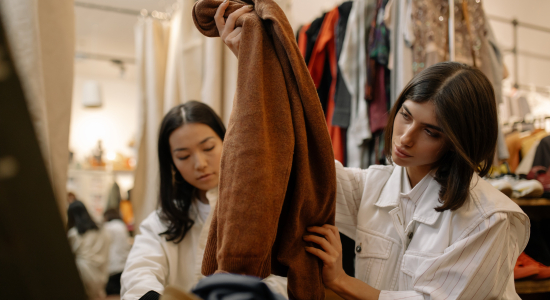What is Slow Fashion & How Can You Support It?

Photo by cottonbro studio
In recent years, there has been a growing movement toward sustainable and ethical practices in the fashion industry– which is great news! As concerns about environmental impact and worker exploitation continue to rise, more people are seeking mindful alternatives to the dangerous fast fashion industry. One such alternative is what’s called slow fashion.
Understanding Slow Fashion
Slow fashion is a philosophy and approach to fashion that emphasizes quality, longevity, and sustainability. It encourages consumers to be more conscious about their clothing choices, considering the environmental and social impact of the garments they purchase!
Unlike fast fashion, which promotes quick turnover and mass production, slow fashion encourages a more thoughtful and deliberate approach to clothing. It prioritizes humanity and the planet over convenient exploitation!
Key Principles of Slow Fashion
1. Ethical Production: Slow fashion promotes fair labor practices, ensuring that garment workers are paid fair wages and provided with safe working conditions. It seeks to eliminate exploitative labor practices commonly found in the fast fashion industry.
2. Sustainable Materials: It also prioritizes the use of sustainable and eco-friendly materials. This includes utilizing organic and natural fibers, reducing waste, and supporting recycling and upcycling initiatives.
3. Timeless Design: Companies that practice slow fashion advocate for timeless, classic designs that transcend seasonal trends. The focus is on creating garments that can be worn for years, reducing the need for constant purchases and minimizing waste.
4. Local and Artisanal Production: Supporting local artisans and craftsmen is a fundamental aspect of slow fashion. By purchasing locally made garments, you contribute to the preservation of traditional techniques and help build sustainable economies within communities.
How You Can Support Slow Fashion
Educate Yourself: Making an impact on the way you consume fashion starts with learning more about the fashion industry and its impact on the environment and society. Reading this blog is a great first step! Continue researching to understand the difference between fast and slow fashion, and familiarize yourself with sustainable and ethical brand alternatives.
Choose Quality over Quantity: Instead of buying cheaply made clothes that will fall apart after just a few wears, invest in well-made, durable garments. Look for clothing made from organic or sustainable materials that will stand the test of time.
Shop Secondhand: Secondhand clothes aren’t just for our kids! Embrace thrift stores, consignment shops, and online platforms that specialize in selling secondhand clothing. Buying pre-loved items extends their lifespan while also reducing the demand for new products.
Support Sustainable Brands: Support slow fashion by seeking out and supporting brands that prioritize sustainability and ethical practices. Look for official certifications such as Fair Trade, Global Organic Textile Standard (GOTS), or Bluesign that ensure responsible production in the supply chain.
Practice Minimalism: Adopt a minimalist mindset and curate a wardrobe based on versatile pieces that can be mixed and matched. Avoid succumbing to trends that quickly come and go.
Mend and Upcycle: Extend the life of your garments by repairing them when needed. Learn basic sewing skills or find local tailors who can help you mend and alter your clothes. You can also get creative and upcycle old garments into new and unique pieces.
Rent or Borrow: For special occasions or one-time events, consider renting outfits instead of buying them new! You can also borrow clothes from friends or family for occasional wear, reducing the need for excessive purchases.
Slow fashion is a conscious and sustainable approach to clothing consumption that aims to counter the negative effects of fast fashion. By understanding its principles and adopting mindful practices, we can support the movement and make a positive impact on both the environment and society. Together, we can shape a future where fashion is both stylish and sustainable!